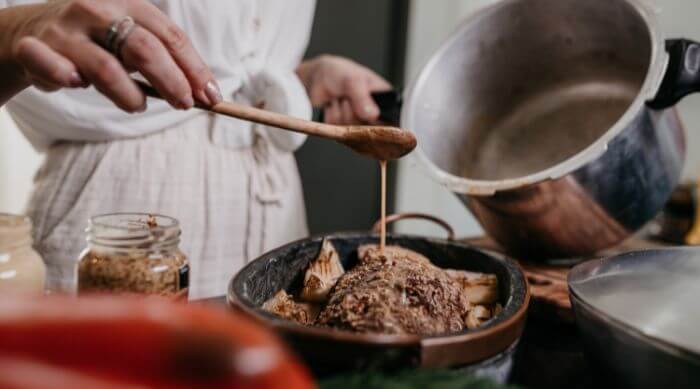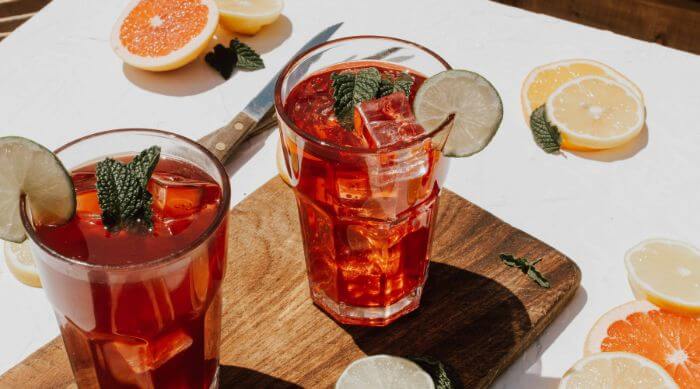If you love cooking with wine, you don’t need to give it up when you cut back on drinking. Whether you’re moderating your drinking or cutting out alcohol altogether, non-alcoholic wines can help you keep your favorite dishes in your repertoire.
High-quality dealcoholized wines aren’t a sacrifice for flavor, either. You may just need to be a little creative and more intentional with your choices as you navigate cooking with non-alcoholic wine.
Table of Contents
1. Only cook with wine you would actually drink.
2. Let the wine breathe before cooking.
4. Tweak the flavor with other ingredients.
5. Choose the right wine for your dish.
More Non-Alcoholic Substitutes for Boozy Recipes
Looking for the best non-alcoholic wine for your pantry and your glass?
Why cook with wine?
Cooking with wine is about adding flavor to your dish, not about raising the ABV of your dinner guests. If a recipe calls for wine with acidity, a crisp white wine may show up in the ingredients list to add brightness to a dish.
A red wine can be used to add depth to beef stews, tenderize short ribs, or as a base for a variety of sauces. Both types of wine are good for deglazing your pan.
Can you use nonalcoholic wine for cooking? Yes, you can cook with nonalcoholic wine, as long as it is of high quality.
A dealcoholized bottle of wine doesn’t have to lack in similar flavors. High-quality non-alcoholic wine brands start out with the same winemaking processes as conventional winemakers.
The alcohol is removed at the end through processes like vacuum distillation, reverse osmosis, or spinning cone technology. That level of attention to filtration is why a high-quality bottle of non-alcoholic sauvignon blanc can be just as crisp and bright as a conventional wine.
1. Only cook with wine you would actually drink.
This is an important one for both regular wine and wine substitutes. If you wouldn’t drink it, you shouldn’t use it in your food, either. Any funky flavors in your wine glass are going to show up in your dish.
Start with a high-quality bottle of wine that you know tastes good all on its own, even your favorite non-alcoholic red wine.
This should go without saying: don’t use off wine as your cooking wine.
2. Let the wine breathe before cooking.
You’ve probably heard about letting the tannins mellow in red wines that are a little too bold right out of the gate. A non-alcoholic wine’s flavors can change in a similar way.
Dealcoholized wines may not have the same aromatics and textures as conventional wine, but give them some time to sit after opening to reveal some additional body. Choose high-quality brands that don’t rely on additives like added sugarfor flavor.
3. Turn down the heat.
Alcohol has a lower boiling point than water, so most recipes account for that by reducing sauces at a lower temperature. Since you’re not dealing with alcohol content, you may be tempted to speed things up a bit and turn up your burners. Avoid the urge.
Give your sauces just as much time and attention without the booze as you would with conventional wine. Your recipes won’t reduce as quickly, but it’ll give you time to allow those flavors to blend. You can always adjust as you go.
4. Tweak the flavor with other ingredients.
If your alcohol-free wine isn’t giving you the flavor profile you’re after, tweak the flavor in other ways. Add blended herbs or spices if your wine is a little too sweet. Use a dash of cocoa powder to bring out rich notes in a non-alcoholic red wine.
Most non-alcoholic wines are just naturally sweeter than conventional wines. While some recipes call for a fortified port or dessert wine to sweeten up a dish, you can always add balance with lemon juice or vinegar for acidity.
Treat dishes that use non-alcoholic wine just like anything else. Taste as you go and add flavor where it’s lacking. Adjust along the way. If you like where things are going, make notes to replicate your efforts next time.
5. Choose the right wine for your dish.
Non-alcoholic wine can be a delicious substitute for conventional wine, but the flavor profile won’t match conventional wine exactly. If you’re open to experimenting, you’ll find ratios that work for you and your favorite dishes.
Start with recipes that call for conventional wine. Here are a few of our favorites:
- Beef bourguignon: This classic French stew usually calls for several cups of red wine like merlot or pinot noir. You may not need to be as heavy-handed with a non-alcoholic red, as they’ll add a sweetness to your dish. Make it more savory with more beef bouillon.
- Risotto bianco: Lemony risottos typically call for a dry white wine or vermouth. Swap those for a non-alcoholic white at a 1:1 ratio. A little extra Parmesan cheese at the end won’t hurt, either.
- Oysters with rosé mignonette: A mignonette is a light sauce made of shallots, white wine vinegar, and pepper. Make it fancier with a non-alcoholic sparkling rosé for a festive oyster appetizer.
- Shrimp puttanesca: Pasta sauces are a great way to use leftover wine. Ragus are best with bold reds, but fish and shrimp work best with a dry white wine. Puttanesca recipes often call for sugar. Skip that when using non-alcoholic wine until you taste your sauce.
- Champagne hollandaise: Upgrade your brunch menu with eggs Benedict topped in a sparkling hollandaise sauce. Non-alcoholic sparkling wines are an easy swap for conventional Champagnes and fizzy wines in these kinds of recipes.
More Non-Alcoholic Substitutes for Boozy Recipes
Non-alcoholic wine isn’t the only wine substitute you should keep in your pantry, especially as you learn how to nail those flavor profiles.
How do I substitute wine in a recipe? If you’re looking for non-alcoholic substitutes for red wine, try these:
- Red wine vinegar is great in dressings, marinades, and for deglazing your pan. Thanks to fermentation, there may be trace amounts of alcohol in this one. In most commercial vinegars, though, most of the ethanol is converted into acetic acid.
- Cranberry juice or pomegranate juice can give your recipe some of the richness of red wines like cabernet sauvignon. They can also add that deep red color to your dish.
- Red grape juice is usually much sweeter than the tart fruit juices above, but it can be a tasty addition to sauces if cut with some acidity. It also offers some of the same health benefits of red wine. Just watch the added sugars in fruit juice.
- Beef stock has a more savory flavor than other broths. It’s great for meaty dishes and as a simmering base in recipes that call for big red wines.
If you need a white wine substitute, try these common pantry items:
- White wine vinegar is more acidic than most white wines. Diluting it by half should do the trick for dressings and sauces that call for white wines like dry chardonnay or pinot grigio. Just like red wine vinegar, it’s also great for deglazing a pan.
- Apple cider vinegar can be used in a 1:1 ratio when replacing white wine in dishes that need a little sweetness. It’s also a good balance for spice and delicious in glazes.
- Apple juice or white grape juice can work well in a pinch. You may need to add a little lemon juice or white wine vinegar to balance out some of the sweetness.
- Chicken or vegetable stocks are more mellow than beef stock and great for layering flavors in seafood and chicken dishes. As with beef stock, you may want to add some acid.
Quick note: If your recipes call for beer, non-alcoholic beer is a great substitute. Just follow the same rule about choosing types of beer that you’d usually drink. Avoid beers with too much bitterness — it can get more pronounced as they cook down.
Looking for the best non-alcoholic wine for your pantry and your glass?
Most recipes don’t call for a full bottle of wine, so you’ll likely have some left over when it’s time to serve your meal. Make sure it’s a high-quality option like Surely non-alcoholic wine. Our wines are delicious on their own or mixed in your favorite mocktails and food recipes.
For picnics or a dinner party on-the-go, try our canned options like the non-alcoholic bubbly red. This fruit-forward blend is our fizzy take on your favorite reds.





![What Is Non-Alcoholic Wine [How It’s Made + Nutrition Facts]](https://dropinblog.net/34240221/files/featured/surely-non-alcoholic-wine.jpeg)
![40 Best Non-Alcoholic Spirits [+ NA Wine & Beer]](https://dropinblog.net/34240221/files/featured/non-alcoholic-spirits-feature.jpg)